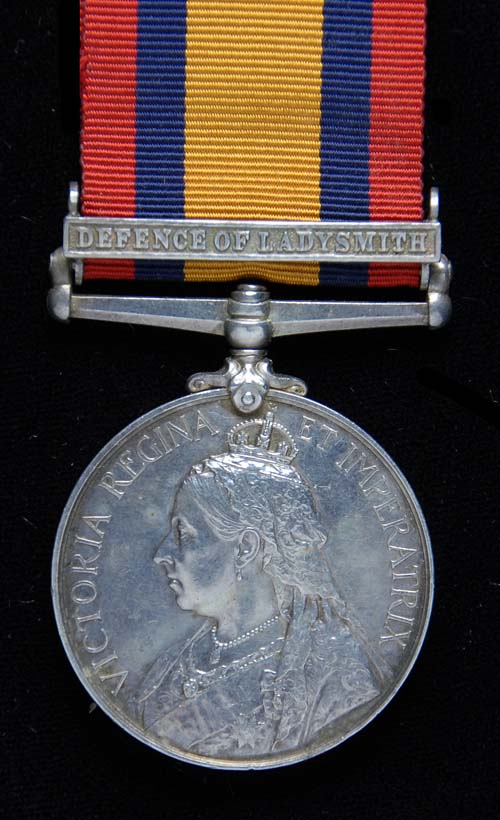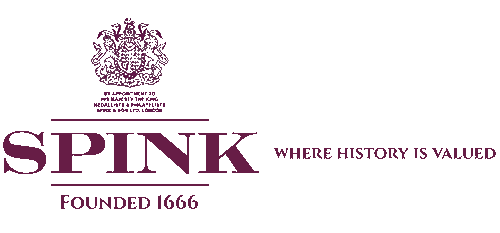
Auction: 11011 - Orders, Decorations, Campaign Medals & Militaria
Lot: 62
A Particularly Fine ´Defence of Ladysmith´ Naval Brigade Officer´s Q.S.A. to Midshipman, Later Commander, C.R. Sharp, Royal Navy, Who Was the Youngest Member of Lambton´s Brigade, and Was Mentioned in Despatches For His Services During the Defence. Sold With Comprehensive and Important Primary Source Archive Material Relating to the Naval Brigade´s Role, and Daily Actions During the Defence of Ladysmith - As a Consequence Extremely Rare, and Unusual to be in Private Ownership Queen´s South Africa 1899-1902, one clasp, Defence of Ladysmith (Mid: C.R. Sharp, R.N. H.M.S. Powerful), impressed naming, light contact marks, good very fine, with the following important primary source archive material of Naval and Boer War interest, formerly used as a research resource by Gerald Sharp, son of Midshipman C. R. Sharp, for his book The Siege of Ladysmith, published by Macdonald & Jane´s, 1976, a copy of which accompanies this lot: - Midshipman C. Reynolds Sharp´s large format Defence of Ladysmith Diary, titled by the author H.M.S. Powerful, Naval Brigade Journal of The Siege of Ladysmith 1899-1900, hard covers under contemporary cloth jacket decorated on front board with an H.M.S. Powerful cap tally band, the contents comprising approximately 54 pages (of approx. 100pp.) filled with manuscript, day by day entries, detailing military events and personal commentary on the 119 day defence; also includes a competent pen and ink plan of the Defence and Siege, and a frontispiece watercolour plan of a ´12 pounder 12 cwt gun mounting for field service´. Volume size approx. 250mm x 195mm; Sample entry - 6 January 1900: ´... Lealham , stoker, was killed and Ward AB was severely wounded in the arm. Mr Sheen was slightly wounded having his face cut about a good bit. It was found that several Boers had got right up to the sangars and opened fire at the same time shouting ´Retire´. About 3pm Rifleman´s Ridge opened fire on Waggon Hill and raked it with shrapnel the Boers made another attack later in the evening .... Our casualties mount up to about 250 killed and wounded. The Boers must have lost enormously ...´ - Queen´s Regulation Log Book of Midshipman C. R. Sharp, hard covers under contemporary cloth jacket decorated on front cover with H.M.S. cap tally bands for Terrible, Powerful, Resolution and Gibraltar, approximately 55 pages of manuscript entries, technical drawings, pen and ink charts and cross-sections, compiled during service 1899-1901 in the aforementioned ships, Volume size approx. 320mm x 215mm - Boer War period letters written by Midshipman C. R. Sharp, including one penned during the Defence of Ladysmith. - Conduct Certificates of C. R. Sharp, including one signed by Captain Hon Hedworth Lambton, R.N., H.M.S. Powerful, who commanded the naval brigade in Ladysmith, and one signed by Captain Sir Percy Scott, R.N., H.M.S. Terrible., who designed naval mountings for use ashore in South Africa, and during the First World War played a leading role in anti-Zeppelin measures. - Aural archive material, comprising a CD (two copies) and one audio cassette recording C. R. Sharp´s reminiscences of life in the Victorian Navy and during the Defence of Ladysmith, with typescript; together with two further audio cassettes and original documents relating to Sharp´s experiences in early submarines and during the First World War whilst King´s Harbour Master at Berehaven, Bantry Bay, Ireland; together with C. R. Sharp´s 1899 pocket book with pencil diary entries, and a small pocket diary, brief entries, for 1903. - Signing-in Book of the Ladysmith Siege Officers´ Dining Club 1902-51, containing the signatures of officers, war correspondents and guests who attended the Ladysmith Day dinners in London during the years 1902-1951, the World Wars and 1936, when George V died, excluded. Guest signatures include Lord Athlone and the Prince of Wales (afterwards Edward VIII). Volume size 265mm x 215mm. Recently rebound and titled, contents good. Together with a quantity (approx. 130) of original related correspondence, including signed letters from Lord Roberts, Lord Milner, Sir Ian Hamilton, Sir Percy Marling, V.C., Sir Hubert Gough, siege correspondent Henry Nevinson, and Jan Smuts; officially printed list of officers present during the Siege of Ladysmith; two club secretary´s address books; nine typescript invitation envelopes addressed to officers who were discovered to have been killed in South Africa; a signed 1937 Ladysmith Dinner menu; two original reunion dinner photographs, circa 1951; a signed 1937 Ladysmith dinner menu; a large studio quality souvenir group photograph from the 1928 Ladysmith Dinner, with participants named; two original reunion dinner photographs, circa 1951 and a number of modern photographic reproductions of Ladysmith dinners and negatives - A quantity of modern photographic reproductions and negatives of the Naval Brigade and Gordon Highlanders in South Africa and at Ladysmith during the Boer War; a quantity of related copy photographic material collected by Gerald Sharp; together with a quantity of original and copy photographic images of C. R. Sharp, including some fine studio portraits, generally good condition (lot) Estimate £ 5,000-7,000 17 officers served with Lambton´s Naval Brigade for the Defence of Ladysmith. Predominantly picked from the crew of H.M.S. Powerful, there were also two young midshipmen from the Terrible, Edward George Chichester and Charles Reynolds Sharp, both aged sixteen. Commander Charles Reynolds Sharp (1883-1966); educated as a chorister at Magdalen College School, Oxford; entered H.M.S. Britannia as a Cadet, 1898; passed out in August the following year, and on appointment to H.M.S. Orlando on the China station, he was directed to take passage in the heavy cruiser Terrible sailing from Portsmouth; with the outbreak of hostilities imminent in South Africa, H.M.S. Terrible was ordered to rendezvous with her homeward bound sister ship H.M.S. Powerful at Simonstown; having arrived Sharp transferred to H.M.S. Powerful (Captain Hedworth Lambton), 26.9.1899; Lambton proceeded in the Powerful to Durban in answer to an urgent request for naval guns from Sir George White in Ladysmith; from Durban, Sharp as part of Lambton´s 266-strong naval brigade, proceeded by rail on the last train to reach Ladysmith before the Boers cut the line and besieged the town; At sixteen Sharp was the junior midshipman and youngest member of Lambton´s naval brigade, ´From 1 November to 5 December, 1899, 3,264 Boer shells were recorded as falling in Ladysmith, killing thirty-one civilians and wounding 145. Ladysmith Town Hall, which was being used as a hospital, was badly damaged, despite the Red Cross flag flying over it... Young Midshipman Sharp managed to purloin one of the stone balls that fell from the Town Hall clock tower following its rude assault from ´Long Tom´. It is indicative of the lad´s youthful determination that he even managed to carry the unwieldy object home, where it sits to this day on a special plinth in a lovely Cornish garden, with a plaque beneath it proclaiming its historical significance. It is believed, on the basis of information received from a reliable South African informant, that the civic authorities in Ladysmith would appreciate its return.´ (Field Gun Jack versus the Boers, The Royal Navy in South Africa 1899-1900, Tony Bridgland, refers); Sharp was mentioned in despatches for his service at Ladysmith and was recommended for early promotion on qualification for the rank of Lieutenant (1903); upon their return to England, the officers and men of Powerful´s Ladysmith Brigade were invited to an inspection by Queen Victoria at Windsor Castle, May 1900, ´Midshipman Sharp had been the youngest and most junior officer present. He was therefore the last to be presented and stood quite close to the Queen while waiting his turn. Recalling the experience, in the mid-1960s at over eighty years of age, he said that for the rest of his life he had always remembered her voice very clearly. Indeed, in those days of pre-radio, he was one of the few commoners to have heard it.´ (Ibid). Appointed Lieutenant H.M.S. Resolution (battleship), July 1900; transferred to the newly formed, and at the time, secretive submarine branch, 1904; served in the Holland-class submarines, the first submarines built for the Royal Navy ; he commanded Holland 2 before he was given command of A10, at Plymouth - ´a devil of a boat - you had to have your hair parted in the middle to keep her afloat´; and in 1907 Sharp received command of C2 , conversely, ´a magnificent boat´; during the Great War he was stationed at Berehaven, Ireland, where he combined the duties of King´s Harbour Master, Chief Examination Officer and Coaling Officer, and was involved in the salvaging of ships torpedoed by U-boats; retired 1922, and was re-employed for service during the Second War in Naval Control work based in the U.K. and in Stockholm; for fifty years Commander Sharp was a stalwart of the annual Ladysmith reunion dinner held on the anniversary of the relief (28 February); from 1935 Sharp acted as secretary to the gathering until the final dinner at Claridges in 1951 by which time it was concurred ´we were getting too old to assemble in London in mid-winter.´
Sold for
£4,800




